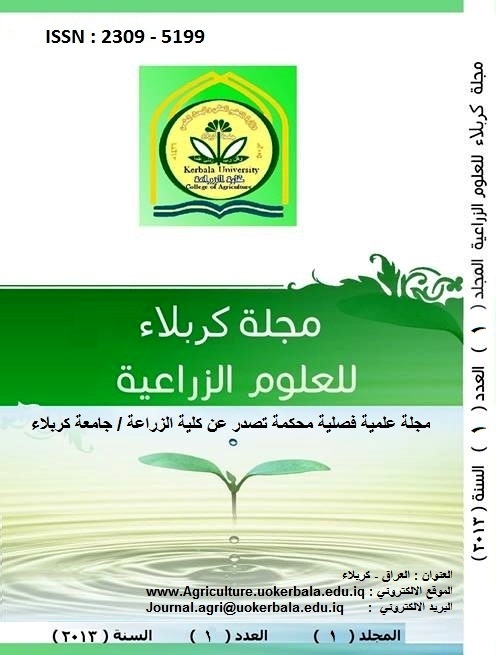Effect of tillage deep and phosphate fertilizer in growth and yield of sun flower (Helianthusannuus L.)
DOI:
https://doi.org/10.59658/jkas.v1i1.330Abstract
An experiment was carried out during the 2001 and 2002 growing seasons at Akad horticulture station , Shatra , Theqar governorate .This study was conducted to investigate the influence of plowing depth and phosphorous fertilization on growth and yield , its components , oil percentage and oil yield of sunflower for variety Peredovick. Also there interactions .
Split plots arrangement in (R.C.B.D) with four replicates was used. The main treatment was the plowing depth (0-20) cm and (0-40) cm, where as the fertilizer levels of phosphor (0, 80 and 160) kg p2o5/ha was used as sub treatment. The area of experiment unite was (3*3) m contained (4) rows, planting at (75*30) cm space. Results showed that plowing depth (0-40) cm gave higher values for most characteristics during y the two study seasons 2001 and 2002 respectively. Results olso showed that deep plowing (0-40)cm gave a higher yield of seed (2.246 , 2.351) ton / ha , higher oil percentage 40.9 % and 41.1 % and oil yield ( 0.928 , 0.973) ton / ha during for two study seasons 2001 and 2002.
The fertilizer levels of (160) kg P2O5 /ha gave higher yield of seed ( 2.372 , 2.064) ton / ha ,oil percentage 42.2 % , 42.0 % and oil yield (1.006 , 1.032) ton/ha for two study seasons 2001 and 2002. Therefore the best combination was deep plowing (0-40) cm with 160 kg/ha P2O5 increased the yield of seed which was (2.610 , 2.682) ton/ha and oil percentage 44.6 % , 44.9% also increased the yield of
oil which was (1.138 and 1.183) ton/ha for 2001 and 2002 respectively.
Downloads
Published
How to Cite
Issue
Section
License
Copyright (c) 2013 Copyright (c) 2024 is the Author's article. Published by the Journal of Kerbala for Agricultural Sciences under a CC BY 4.0 license

This work is licensed under a Creative Commons Attribution 4.0 International License.
Licensing Terms
All articles are published under a Creative Commons License and will be directed to the Creative Commons Attribution 4.0 International License (CC BY 4.0) That permits use, distribution, and reproduction in any medium, provided the original work is properly cited. This license also allows the work to be used for commercial purposes.
Use by both non-commercial and commercial users
This content is licensed under a Creative Commons Attribution 4.0 International (CC BY 4.0) license, permitting use by both non-commercial and commercial users. Individual users may access, download, copy, display, and redistribute the articles to colleagues, as well as adapt, translate, and text- and data-mine the content, subject to the following conditions:
- The author's moral rights, including the right of attribution and the right to protect their work from derogatory treatment, are respected.
- Where content in the article is identified as belonging to a third party, users must ensure that any reuse complies with the copyright policies of the owner of that content.
- If the article content is reused for research or educational purposes, users should maintain a link to the appropriate bibliographic citation, including the DOI and a link to the published version on the journal's website.

